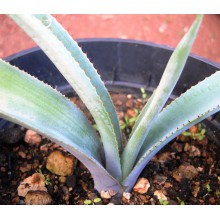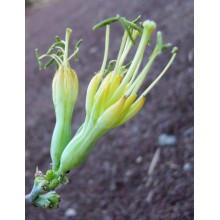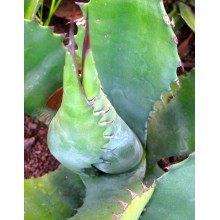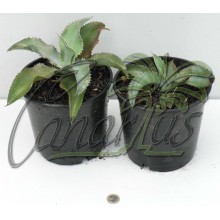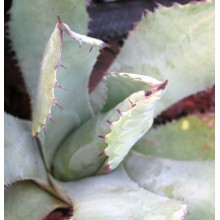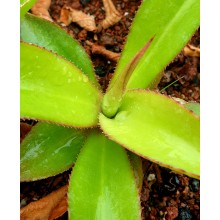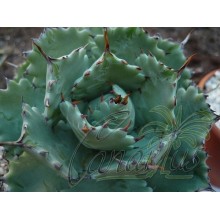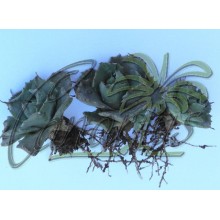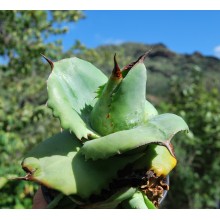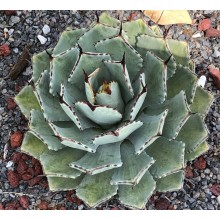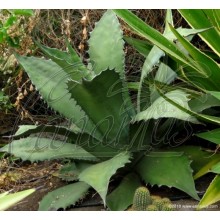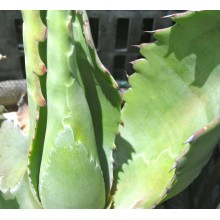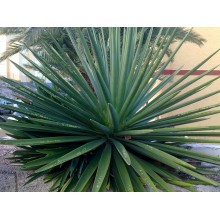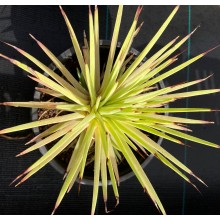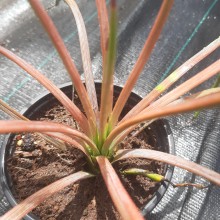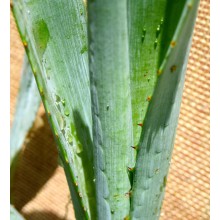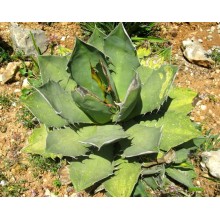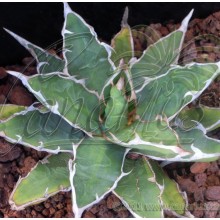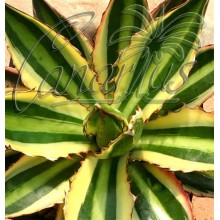Succulents There are 628 products.

World deserts and dry areas are home to the most interesting plants. Canarius offers an increasing selection of succulent plants of maximum quality, because they are grown outdoors, under the full sun of the Canary Islands.
Succulents or "fat plants" are water-retaining species, adapted to dry conditions. They store succum (juice, water) in their leaves, stems or roots, and often show a stout and fleshy appearance.
Subcategories
-
Agave
Agave is a genus of succulent plants from America. Some species grow in cold areas and take hard frost, while some others live in tropical climates. Some are tiny dwarfs and some are giants, up to 2 or 3 m wide.
Cold hardy agaves can create an exotic effect in your garden. Agave species make fine companions to palms or cacti. Variegated agaves are incredibly sought after by collectors. Our web shop offers an ever changing selection of species. We ship bare rooted plants, unless otherwise specified.
-
Aloe, Gasteria & Haworthia
Aloe, Gasteria and Haworthia are three related genera, comprising hundreds of succulent plants. They are all easily grown in pots. A few adapt to low-light levels of indoor conditions and can be grown as house plants.
- Aloe is a genus of about 400 species, native to Africa, Arabia and Madagascar. Small or dwarf aloes are becoming especially popular in colder climates as they can be taken indoors during the hardest months.
- Gasteria includes some 80 species endemic to South Africa, known for their spectacular leaves which are glossy, mottled and textured. They bloom in Spring-Summer with long spikes of small orange flowers. Some species are so variable that we offer particular clones from specific locations.
- Haworthia is a genus endemic to South Africa with about 70 species and a number of local subspecies, varieties and forms. Leaves are often banded, speckled, dotted, or semi-translucent and show wide variations.
-
Crassulaceae
This is a new, growing section of species from the family Crassulaceae. There are about 1,400 species in 33 genera and their distribution is worldwide, but mostly occur in the Northern Hemisphere and Southern Africa, especially in dry habitats. Here you can buy healthy, sun-hardened plants grown in the Canary Islands and shipped to your home.
-
Mesembs
This group of desert plants is briefly named Mesembs because they belong to a botanical family formerly named Mesembryanthemaceae. There are almost 2.000 species, mainly found in Southern Africa, with extreme adaptations to dry habitats. Some are called "living stones", as they look like pebbles. Many are easy to grow and their main need is full sun. Some are difficult because they grow in truly extreme areas.
Our Web Shop offers sun grown healthy plants, with compact and colourful leaves. Some plants are sold as cuttings, and others as rooted plants, of at least two years old.
-
Sansevieria
Recently assigned to the family Asparagaceae, the genus Sansevieria counts about 70 species, nearly all native to Africa, Arabia and Madagascar. Perennial herbs adapted to dry habitats with stiff, succulent leaves, their length ranges from a few centimeters to 2 meters. Sansevieria trifasciata and its many cultivars are among the most popular houseplants, popularly called mother in law's tongue. A well grown plant usually produces a spike of many white, richly scented flowers and then orange berries. Even the rarest species are resistant to neglect, provided you keep them from frost in winter and scorching sun in summer.
-
Hoya
Hoyas are twining vines, with showy exotic flowers, from the rainforests in Asia and Oceania. Most species grow in bright shade or morning sun, but they will also grow indoors as house plants. They are well suited for baskets, trellises or ladders. They tolerate a few weeks of drought but they are sensitive to frost and cold. Many hoyas are easy to grow and bloom, while some are tricky and rare.
-
Asclepiads
Asclepiads or Asclepiadoideae are a subfamily in the Apocynaceae, with about 2900 species. There are lots of leafless stem succulents but also perennial herbs, shrubs, lianas or rarely trees. They produce remarkable flowers, for the complex mechanisms they have developed for pollination. Many species produce an unusual fragrance, often called "carrion", and attracts flies for pollination. -
Caudiciforms
These plants from dry areas produce an unusually thick stem, the caudex. They are also called pachycauls and they have a disproportionately thick trunk, often with few branches. The caudex can be hidden underground, but in most cases they grow upwards, forming spectacular trees. The largest caudiciforms in the world are the baobabs. -
Other succulents
Here you will find all those species of desert plants that are not included in their own category. We will place here all plants from unusual families, other than Agaves, Aloes, Crassulaceae, Sansevieria, Mesembs, Epiphytic cacti, etc.
-
Agave neomexicana
Agave neomexicana
This is a very cold hardy species with thick succulent silver gray leaves, edged with purple-black spines. It is a small plant, less than 1 m tal. It is native to Texas, south of the border with New Mexico, on rocky limestone slopes and grasslands. It can resist temperatures as low - 18 C.
12,60 € -
Agave nizandensis
Agave nizandensis
This is a truly different agave, an absolute miniature beauty, with soft and brittle Aloe-like leaves. Leaves are tender, dark green with a paler stripe in the middle. It thrives in semi-shade, in warm and wet but well drained conditions. It can even be used in terrariums, or as an epiphye.
32,00 € -
Agave oroensis
Agave oroensis
Known from Concepción del Oro, in Zacatecas state Mexico, at about 1800 m elevation, this Agave grows into a stately specimen, with robust sygmoid leaves, with a blue-grey-green polychrome banding similar to Agave americana. It takes frost and hard conditions.
11,70 € -
Agave pablocarrilloi
Agave pablocarrilloi
Elegant, exotic and unique Agave, with naturally curly blue leaves. It has a different shape because of the grey-blue leaves with wavy, undulate leaf margins with widely and regularly spaced daark theeth.
14,00 € -
Agave pendula
Agave pendula
Quite different and attractive, this agave has few leaves and they are fleshy and soft, with a pale green colour, reminiscent of Agave attenuata.
24,30 € -
Agave potatorum
Agave potatorum
14-18 cm pot, bare rooted - Small to medium sized, compact Agave with embossed glaucous leaves. Margins are undulate and armed with reddish-brown spines. It is a mountain species from southern Mexico, found at 1300 to 2300 m (4500 to 7500 ft.).
11,30 € -
Agave potatorum 'Shoji Rajin'
Agave potatorum 'Shoji Rajin'
Agave of 5-7 cm (2-3 in). Dwarf Japanese selection of Agave potatorum. It is very compact and grows only to 5-10 cm (2-4") in diameter. Leaves are wide, thick and dusty blue, with few spines.
12,00 € -
Agave potatorum 'Short Form'
Agave potatorum 'Short Form'
Small sized, compact Agave with short rounded leaves. This selection is especially attractive with a lovely leaf shape. It is easy to grow and hardy, just as the more widespread forms of Agave potatorum, with the typical glaucous leaves with maroon-black spines.
24,50 € -
Agave potatorum ‘Kichiokan’
Agave potatorum ‘Kichiokan’
14-18 cm pot, bare rooted - Small to medium sized, compact Agave with embossed glaucous leaves. Margins are undulate and armed with reddish-brown spines. It is a mountain species from southern Mexico, found at 1300 to 2300 m (4500 to 7500 ft.).
23,40 € -
Agave salmiana var. ferox
Agave salmiana var. ferox
10 cm cutting. A giant in the genus, the ferocious classic Agave ferox can take some frost and snow.
11,70 € -
Agave scabra
Agave scabra
Our plant is the Agave asperrima described by Jacobi, commonly found in the Chihuahuan Desert. It grows beautiful grey-white, average sized rosettes.
11,80 € -
Agave sisalana
Agave sisalana
NEW - 14-18 cm. This is a millenary crop plant grown for fibres named sisal. It originated in Mexico, Chiapas, and is widelycultivated elsewhere. It is probably a sterile cultivar derived from A. vivipara.
11,80 € -
Agave stricta 'nana'
Agave stricta 'nana'
This small agave has become very popular during the past years because of a lot of reasons. It is an official beauty, spineless except at the tip, with green-blue leaves.
20,80 € -
Agave Tenuifolia
Agave Tenuifolia
Agave tenuifolia features slender tufts of flexible, arching, blue-green foliage. Lax rosettes form loose clumps.
14,70 € -
Agave tequilana
Agave tequilana
The famous tekila drink is produced with this species with grey-blue leaves. Agave tequilana is only known in cultivation, and was never found in the wild, but it was possibly originally native to Jalisco in Mexico. It is a large plant with straight grey-blue leaves. It is hardy to light frost, to about - 3 C.
12,30 € -
Agave triangularis
Agave triangularis
NEW !- Olive-green leaves, finely asperous, with a broad paler band running down the center. Native to an arid calcareous region in Teuhuacan, Puebla, at 1650-1950 m elevation. Slow growing, attaining 50-80 cm in diameter. It will stay smaller in pots.
17,20 € -
Agave univittata 'Quadricolor'
Agave univittata 'Quadricolor'
20-22 cm diameter. Exciting garden selection of a small, frost-hardy agave. Rosettes are compact, tidy and four-coloured (quadri-color). This variegated cultivar will survive - 5 C (23 F) and even less if kept dry.
15,80 € -
Agave univittata 'Quadricolor'- LARGE
Agave univittata 'Quadricolor'- LARGE
25 cm diameter. Exciting garden selection of a small, frost-hardy agave. Rosettes are compact, tidy and four-coloured (quadri-color). This variegated cultivar will survive - 5 C (23 F) and even less if kept dry.
39,20 €
At the moment there are few products in this category Succulents

























